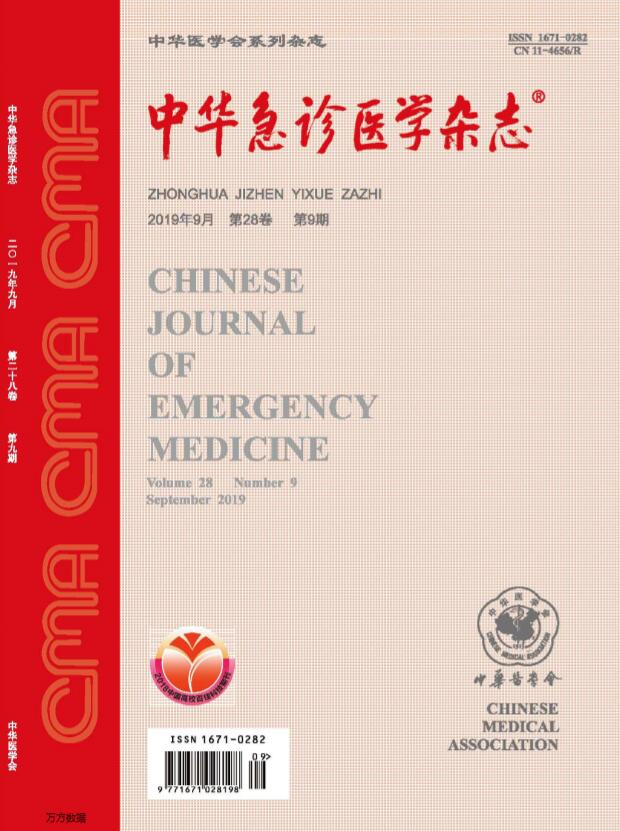ROX指数在评价新冠肺炎患者高流量鼻插管氧疗疗效中的价值
Q4 Nursing
引用次数: 0
摘要
目的:评价ROX指数在评价冠状病毒感染(COVID-19)患者高流量鼻插管氧疗(HFNC)疗效中的价值。方法:回顾性研究。纳入的患者于2020年2月15日至2020年3月15日在华中科技大学同济医学院附属协和医院肿瘤中心重症监护室确诊为COVID-19。所有患者均采用HFNC治疗。根据患者随后是否接受无创正压通气或有创正压通气,将患者分为HFNC成功组和HFNC失败组。采用t检验、卡方检验或秩和检验对两组患者治疗2、6、12 h后的基本特征、乳酸、胸片次数、APACHEⅱ、淋巴细胞计数、基线呼吸频率、基线经皮氧饱和度、基线PaO2/FiO2、基线ROX指数、ROX指数进行分析。结果:本研究共纳入57例。HFNC成功组与HFNC失败组在性别、年龄、合并症、乳酸、胸片肺感染象限、APACHEⅱ、淋巴细胞计数、基线呼吸频率、经皮氧饱和度、氧合指数、ROX指数等方面无显著差异(P < 0.05)。Logistic回归分析显示,HFNC治疗2 h后ROX指数(OR=0.069)、6 h后ROX指数(OR=0.194)、12 h后ROX指数(OR=0.036)均为HFNC治疗COVID-19患者治疗效果的保护因素。ROC曲线显示,HFNC治疗2 h后ROX指数、6 h后ROX指数、12 h后ROX指数差异均有统计学意义(P<0.05)。评价指标中,HFNC治疗2 h后ROX指数的ROC曲线下面积为0.838,敏感性为64.5%,特异性为100%。HFNC治疗6 h后,ROX指数ROC曲线下面积为0.762,敏感性为64.5%,特异性为92.3%。HFNC治疗12 h后,ROX指数ROC曲线面积为0.866,敏感性为67.7%,特异性为100%。结论:ROX指数可以及时、简单、实时地评价手足口病治疗对COVID-19患者的疗效。©2021中华医学会。版权所有。本文章由计算机程序翻译,如有差异,请以英文原文为准。
The value of ROX index in evaluating the efficacy of high-flow nasal cannula oxygen therapy in patients with COVID-19
Objective: To assess the value of the ROX index in evaluating the efficacy of highflow nasal cannula oxygen therapy (HFNC) in patients with coronavirus infected disease (COVID-19). Methods: This is a retrospective study. The included patients were diagnosed as COVID-19 in the intensive care unit (ICU) of the Cancer Center of Union Hospital affiliated to Tongji Medical College of Huazhong University of Science and Technology from February 15, 2020 to March 15, 2020. All the patients were treated by HFNC. According to whether the patient subsequently received non-invasive positive pressure ventilation or invasive positive pressure ventilation, patients were divided into the HFNC success group and the HFNC failure group. Parameters in the two groups such as basic characteristics, lactic acid, number of chest radiographs, APACHE II, lymphocyte count, baseline respiratory rate, baseline percutaneous oxygen saturation, baseline PaO2/FiO2, baseline ROX index, and ROX index after 2, 6 and 12 h HFNC treatment were analyzed with t test, Chi-square test or rank sum test. Results: A total of 57 cases were included in this study. There were no significant differences in sex, age, comorbidities, lactic acid, quadrants of chest radiograph lung infection, APACHE II, lymphocyte count, and baseline respiratory frequency, transcutaneous oxygen saturation, oxygenation index, and ROX index between the HFNC success group and the HFNC faliure group (P>0.05). Logistic regression analysis showed that ROX index after 2 h HFNC treatment (OR=0.069), ROX index after 6 h HFNC treatment (OR=0.194) and ROX index after 12 h HFNC treatment (OR=0.036) were all protective factors for the therapeutic effect of HFNC treatment in COVID-19 patients. ROC curve showed that there were significant differences in ROX index after 2 h HFNC treatment, ROX index after 6 h HFNC treatment, and ROX index after 12 h HFNC treatment (P<0.05). In the evaluation index, the area under the ROC curve of the ROX index after 2 h HFNC treatment was 0.838, the sensitivity was 64.5%, and the specificity was 100%. After 6 h HFNC treatment, the area under the ROX index ROC curve was 0.762, the sensitivity was 64.5%, and the specificity was 92.3%. After 12 h HFNC treatment, the ROX index ROC curve area was 0.866, the sensitivity was 67.7%, and the specificity was 100%. Conclusions: The ROX index can be used to evaluate the efficacy of HFNC in COVID-19 patients in a timely, simple and real-time manner. © 2021 Chinese Medical Association. All rights reserved.
求助全文
通过发布文献求助,成功后即可免费获取论文全文。
去求助
来源期刊

中华急诊医学杂志
Nursing-Emergency Nursing
CiteScore
0.10
自引率
0.00%
发文量
8629
期刊介绍:
Chinese Journal of Emergency Medicine is the only national journal which represents the development of emergency medicine in China. The journal is supervised by China Association of Science and Technology, sponsored by Chinese Medical Association, and co-sponsored by Zhejiang University. The journal publishes original research articles dealing with all aspects of clinical practice and research in emergency medicine. The columns include Pre-Hospital Rescue, Emergency Care, Trauma, Resuscitation, Poisoning, Disaster Medicine, Continuing Education, etc. It has a wide coverage in China, and builds up communication with Hong Kong, Macao, Taiwan and international emergency medicine circles.
 求助内容:
求助内容: 应助结果提醒方式:
应助结果提醒方式:


